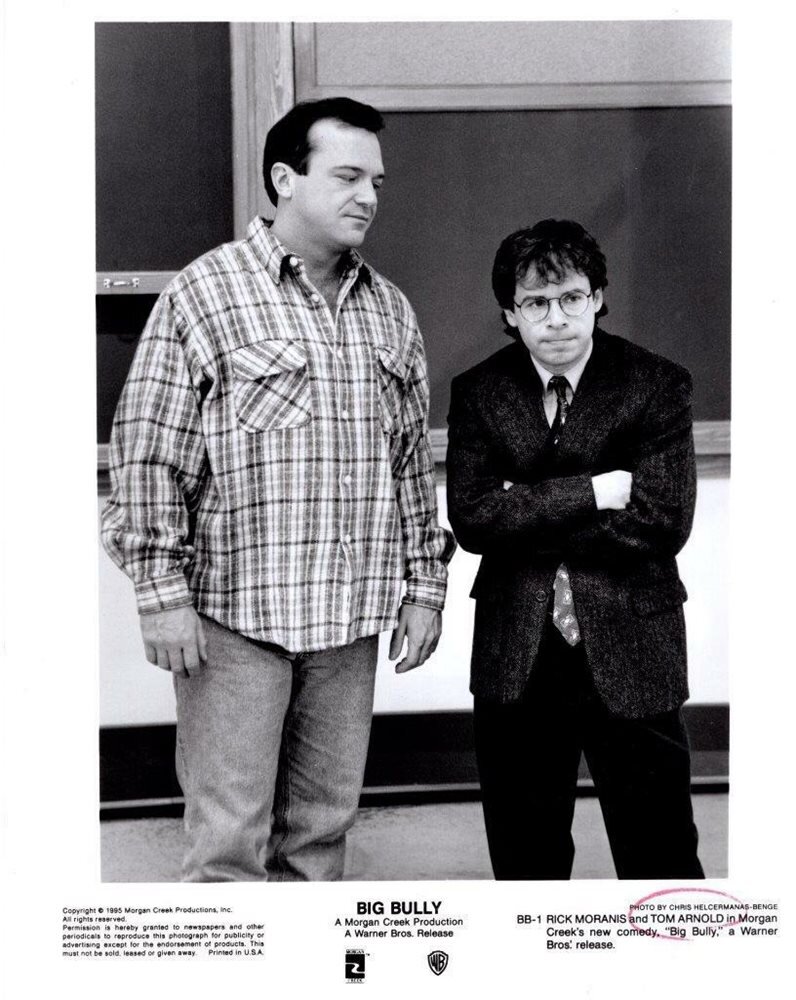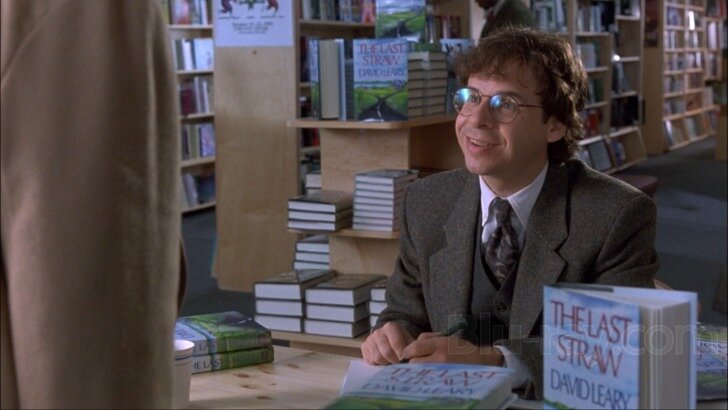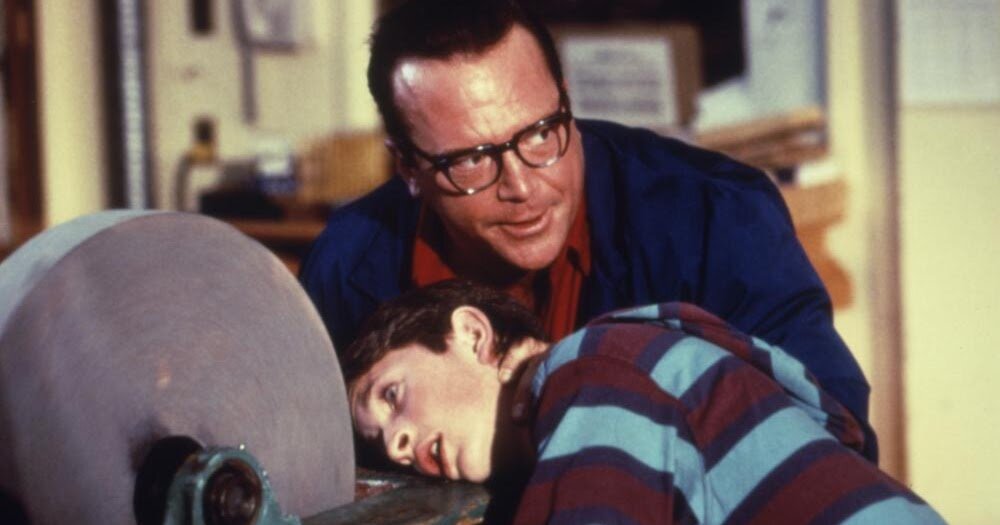Shockingly Bleak My World of Flops Case File #178/Control Nathan Rabin #192 Big Bully (1996)
Welcome, friends, to the latest entry in Control Nathan Rabin 4.0. It’s the career and site-sustaining column that gives YOU, the kindly, Christ-like, unbelievably sexy Nathan Rabin’s Happy Place patron, an opportunity to choose a movie that I must watch, and then write about, in exchange for a one-time, one hundred dollar pledge to the site’s Patreon account. The price goes down to seventy-five dollars for all subsequent choices.
Or you can be like three kind patrons and use this column to commission a series of pieces about a filmmaker or actor. I’m deep into a project on the films of the late, great, fervently mourned David Bowie and I have now watched and written about every movie Sam Peckinpah made over the course of his tumultuous, wildly melodramatic psychodrama of a life and career.
This generous patron is now paying for me to watch and write about the cult animated show Batman Beyond and I also recently began even more screamingly essential deep dives into the complete filmographies of troubled video vixen Tawny Kitaen and troubled former Noxzema pitch-woman Rebecca Gayheart. I also recently began a series chronicling the films of bad boy auteur Oliver Stone.
I’m currently in the midst of writing about the mid-1990s vehicles of Tom Arnold for one very kind, very appreciated patron. It has been a thankless task so far. McHale’s Navy and Carpool are just as dire as their reputations suggest but I found 1996’s Big Bully to be a delightful and unexpected surprise, a shockingly dark comedy that makes inspired use of Arnold’s tricky combination of man-child oafishness, darkness and intensity.
Arnold may be the star of Big Bully but it wisely gives him a surprisingly rich, surprisingly nuanced character actor role in Roscoe "Fang" Bigger, a sad shop teacher whose spirit never quite recovered from an extended stint in a Dickensian juvenile detention center after getting caught stealing a moon rock.
Arnold doesn’t make an entrance until nearly an hour in. When we first see him he is a man defeated, a slumped-shouldered pushover whose overbearing wife Faith (Carol Kane), children and students all completely dominate him.
Then David Leary (Rick Moranis, in his final theatrically released film) moves back to town to teach creative writing after striking out in Oakland with a failed marriage followed by a failed novel.
Once upon a time Fang made pint-sized David’s life a living hell, a torment that only ended when a ten year old David reported him to the cops and his family promptly moved away.
When Fang realizes that his new professional colleague is the adult version of a Poindexter he tormented he instantly reverts back into the monster he used to be, a psychotic jerk who doesn’t just want to annoy David: he wants to destroy him, to break him, to drive him to suicide if necessary.
Big Bully came out the same year as Cable Guy and was similarly mis-marketed as a genial mainstream comedy about a lovable everyman whose life is turned upside down by a lonely, lost man who will not leave him alone rather than as an evisceratingly dark, unrelentingly grim and bitterly funny exploration of the seedy underside of American life.
The critically reviled box-office flop was directed by Steve Miner, who worked on iconic cult movies like The Last House on the Left and Friday the 13th in various capacities before graduating to the director’s chair with 1981’s Friday the 13th Part 2 and then 1982’s Friday the 13th Part 3.
From there Miner alternated between television, horror films of note like House, Warlock, Lake Placid and Halloween H20: 20 Years Later and 1986’s Soul Man and 1994’s My Father, the Hero, which were horrific, alright, but in a much different way than Miner’s fright flicks.
It’s a testament to Big Bully’s weird, tricky, uniquely non-commercial tone that it allows Miner to draw extensively on his experiences directing both nine episodes of The Wonder Years and two Friday the 13th sequels.
Big Bully begins in 1970 like an off-brand Wonder Years knock-off, with Rick Moranis playing the Daniel Stern role of the older and wiser adult looking back on the gentle misadventures of his younger self through narration sprinkled, like the rest of the opening, in the tacky glitter of cheap, easy childhood nostalgia.
Once Arnold re-enters the film as an adult the tone shifts unmistakably into psychodrama and horror. Miner had the inspired idea to essentially shoot Big Bully as a horror movie, a Friday the 13th sequel with the lumbering, glowering, revenge-crazed Tom Arnold in the place of a machete-wielding, hockey mask-clad Jason Voorhees.
But before Big Bully becomes a horror comedy we get a good, long glimpse at the low-key tragicomedy that is our hapless hero’s life. David’s wife left him, then disappeared. A book signing for his literary debut is so sparsely attended he is repeatedly mistaken for a bookstore employee and asked where the Stephen King books are, a gag I personally found painfully relatable. His own son Ben (Blake Bashoff) is a juvenile delinquent and a bully himself.
So when Kevin is offered a chance to return to the small town in Minnesota where he grew up as a conquering hero by Principal Kokelar (Don Knotts) he accepts primarily because he has nothing else going on in his life.
Pretty much from the start everything goes wrong. His creepy next door neighbor Art Lundstrum (a very funny Jeffrey Tambor, in the kind of scene-stealing turn that makes you wish he wasn’t such a distractingly terrible human being in real life) is way too invested in his life and knows way too much about him.
The utterly checked out Principal does nothing to hide his disdain for everything and everybody, including but not limited to his students, his teachers and all of the parents.
Kevin’s fellow teacher/nerd Clark (Curtis Armstrong) hates him with a white-hot burning passion and for no good reason, really and Ben makes a terrible impression on his new school and town by bullying Kirby (Cody McMains), Fang’s son.
But things do not go from bad to worse until Fang realizes that the new teacher at the school is his own arch-nemesis and proceeds to terrorize him in a way that could very well turn fatal.
Big Bully has an utterly bullshit ending that finds David seemingly killing his tormenter by tossing him from a high distance to a watery grave. Like a slasher movie villain, however, Fang proves shockingly hard to kill.
A still living, soaking wet and vengeance-crazed Fang tries to kill David but then they discover the power of friendship and morph instantly from bitter enemies to warm pals.
The first fifteen minutes of Big Bully are forgettable and sappy and its ending represents a massive cop-out but for a solid hour Big Bully is a dazzlingly dark look at the everyday misery that constitutes life among the neurotic middle class in the upper Midwest.
Moranis and Arnold have potent yin and yang chemistry. Arnold apparently thought Moranis didn’t like him when they were making the film. I don’tr know if that’s true or not. If you’re Tom Arnold you probably go through life assuming people don’t like you and are often correct, despite the actor’s innate likability.
If Moranis did in fact not get along with Arnold that tension works for the film. Both men deliver performances that are as dramatic as they are comedic leading to a movie that’s infinitely darker, funnier and more compelling than its reputation would suggest, even with a sappy beginning and wildly out of place upbeat Hollywood ending.
Failure, Fiasco or Secret Success: Secret Success
Pre-order The Joy of Trash: Nathan Rabin’s Happy Place’s Definitive Guide to the Very Worst of Everything and get access to original articles AS I write them and plenty more bonus stuff like exclusive cards featuring Felipe Sobreiro’s amazing artwork for the book at https://the-joy-of-trash.backerkit.com/hosted_preorders/cart
Help ensure a future for the Happy Place during an uncertain era AND get sweet merch by pledging to the site’s Patreon account at https://www.patreon.com/nathanrabinshappyplace
Also, BUY the RIDICULOUSLY SELF-INDULGENT, ILL-ADVISED VANITY EDITION of THE WEIRD ACCORDION TO AL, the Happy Place’s first book. This 500 page extended edition features an introduction from Al himself (who I co-wrote 2012’s Weird Al: The Book with), who also copy-edited and fact-checked, as well as over 80 illustrations from Felipe Sobreiro on entries covering every facet of Al’s career, including his complete discography, The Compleat Al, UHF, the 2018 tour that gives the book its subtitle and EVERY episode of The Weird Al Show and Al’s season as the band-leader on Comedy Bang! Bang!
Only 23 dollars signed, tax and shipping included, at the https://www.nathanrabin.com/shop or for more, unsigned, from Amazon here








